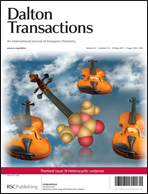A full theoretical mechanistic investigation on the symmetrical cleavage of P4 at the active complex fragments [(η5-C5H5)Co(L)] (L = CO, iPr2Im; iPr2Im = 1,3-di-iso-propylimidazolin-2-ylidene), which results in the formation of the complex [{(η5-C5H5)Co}2(μ,η2:2-P2)2] 9, is presented. The overall reaction mechanism is a complex, multistep process. Rate-determining steps of the reaction sequence are two consecutive dissociations of the co-ligands L, which induce the decisive structural rearrangements of the P4 unit. The choice of the co-ligand L ( = CO, iPr2Im) influences the kinetic barrier as well as the energy balance of the overall reaction path significantly. The calculations further reveal a strong influence of the entropic effect on the overall reaction. As a consequence, the energy balance of the overall formation of 9 starting from [(η5-C5H5)Co(CO)] precursors is almost thermoneutral and has to overcome high kinetic barriers, whereas the reaction starting from [(η5-C5H5)Co(iPr2Im)] precursors is exothermic, featuring lower transition barriers with stabilized intermediates. From the direct comparison of both reaction coordinates it seems that the entropic effect of the co-ligands is even stronger than their electronic influence, as for both investigated systems the reactions’ energy profiles are almost identical up to intermediate [{(η5-C5H5)Co(L)}2(μ,η2:2-P4)] 5 (L = CO, iPr2Im). After the formation of 5, the first CO dissociation step renders the reaction endothermic for L = CO, whereas in the case of iPr2Im dissociation the reaction progresses exothermically. Energy decomposition analysis and fragment analysis provide a picture of the bonding mechanisms between the metal complex fragments and P4 in the case of the most significant intermediates and the final product.
![Graphical abstract: Symmetrical P4 cleavage at cobalt half sandwich complexes [(η5-C5H5)Co(L)] (L = CO, NHC) – a computational case study on the mechanism of symmetrical P4 degradation to P2 ligands](/en/Image/Get?imageInfo.ImageType=GA&imageInfo.ImageIdentifier.ManuscriptID=C3DT50267H&imageInfo.ImageIdentifier.Year=2013)

 Please wait while we load your content...
Please wait while we load your content...